Seat Exeo ST 2013 Owner's manual
Manufacturer: SEAT, Model Year: 2013, Model line: Exeo ST, Model: Seat Exeo ST 2013Pages: 327, PDF Size: 5.07 MB
Page 291 of 327
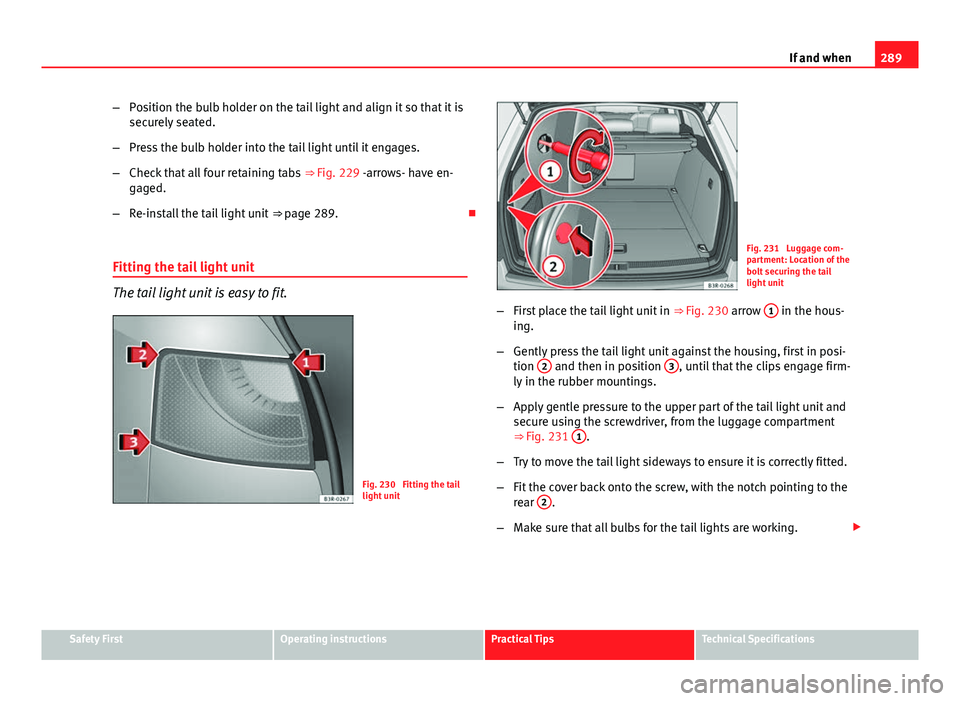
289
If and when
– Position the bulb holder on the tail light and align it so that it is
securely seated.
– Press the bulb holder into the tail light until it engages.
– Check that all four retaining tabs ⇒ Fig. 229 -arrows- have en-
gaged.
– Re-install the tail light unit ⇒ page 289.
Fitting the tail light unit
The tail light unit is easy to fit.
Fig. 230 Fitting the tail
light unit
Fig. 231 Luggage com-
partment: Location of the
bolt securing the tail
light unit
– First place the tail light unit in ⇒ Fig. 230 arrow 1
in the hous-
ing.
– Gently press the tail light unit against the housing, first in posi-
tion 2
and then in position 3, until that the clips engage firm-
ly in the rubber mountings.
– Apply gentle pressure to the upper part of the tail light unit and
secure using the screwdriver, from the luggage compartment
⇒ Fig. 231 1
.
– Try to move the tail light sideways to ensure it is correctly fitted.
– Fit the cover back onto the screw, with the notch pointing to the
rear 2
.
– Make sure that all bulbs for the tail lights are working.
Safety FirstOperating instructionsPractical TipsTechnical Specifications
Page 292 of 327
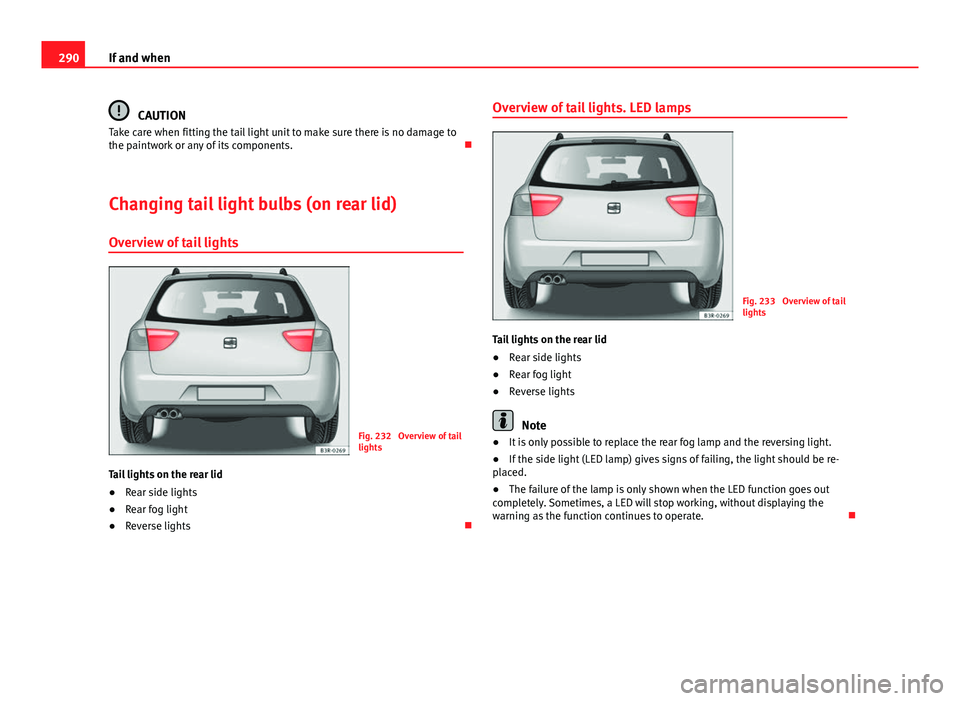
290If and when
CAUTION
Take care when fitting the tail light unit to make sure there is no damage to
the paintwork or any of its components.
Changing tail light bulbs (on rear lid)
Overview of tail lights
Fig. 232 Overview of tail
lights
Tail lights on the rear lid
● Rear side lights
● Rear fog light
● Reverse lights Overview of tail lights. LED lamps
Fig. 233 Overview of tail
lights
Tail lights on the rear lid
● Rear side lights
● Rear fog light
● Reverse lights
Note
● It is only possible to replace the rear fog lamp and the reversing light.
● If the side light (LED lamp) gives signs of failing, the light should be re-
placed.
● The failure of the lamp is only shown when the LED function goes out
completely. Sometimes, a LED will stop working, without displaying the
warning as the function continues to operate.
Page 293 of 327
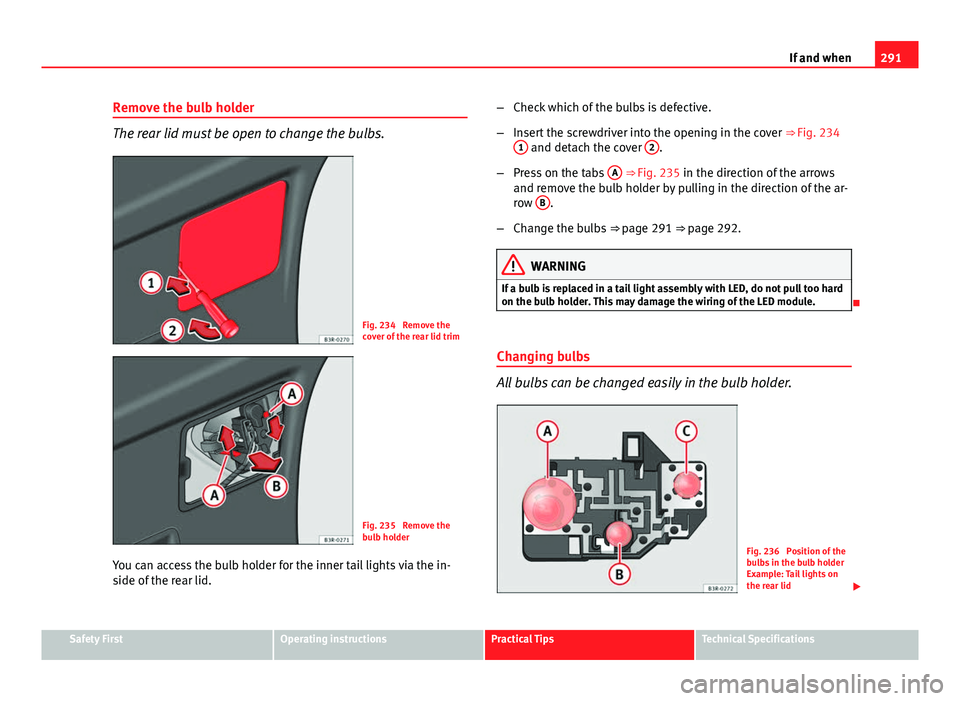
291
If and when
Remove the bulb holder
The rear lid must be open to change the bulbs.
Fig. 234 Remove the
cover of the rear lid trim
Fig. 235 Remove the
bulb holder
You can access the bulb holder for the inner tail lights via the in-
side of the rear lid. –
Check which of the bulbs is defective.
– Insert the screwdriver into the opening in the cover ⇒ Fig. 234
1
and detach the cover 2.
– Press on the tabs A
⇒ Fig. 235 in the direction of the arrows
and remove the bulb holder by pulling in the direction of the ar-
row B
.
– Change the bulbs ⇒ page 291 ⇒ page 292.
WARNING
If a bulb is replaced in a tail light assembly with LED, do not pull too hard
on the bulb holder. This may damage the wiring of the LED module.
Changing bulbs
All bulbs can be changed easily in the bulb holder.
Fig. 236 Position of the
bulbs in the bulb holder
Example: Tail lights on
the rear lid
Safety FirstOperating instructionsPractical TipsTechnical Specifications
Page 294 of 327
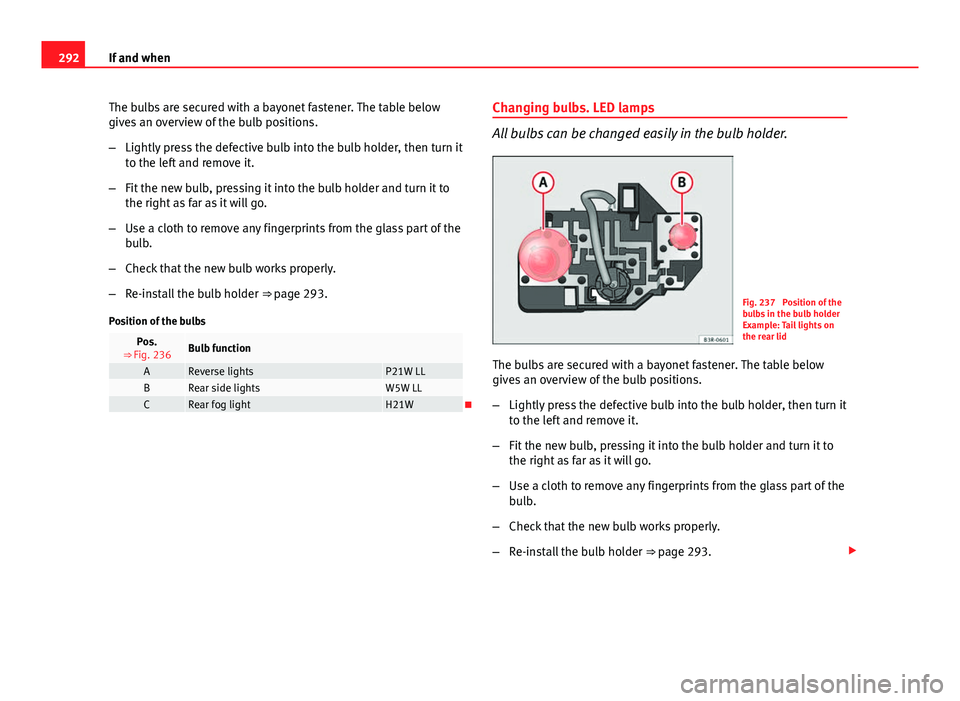
292If and when
The bulbs are secured with a bayonet fastener. The table below
gives an overview of the bulb positions.
–Lightly press the defective bulb into the bulb holder, then turn it
to the left and remove it.
– Fit the new bulb, pressing it into the bulb holder and turn it to
the right as far as it will go.
– Use a cloth to remove any fingerprints from the glass part of the
bulb.
– Check that the new bulb works properly.
– Re-install the bulb holder ⇒ page 293.
Position of the bulbs
Pos.
⇒ Fig. 236Bulb function
AReverse lightsP21W LLBRear side lightsW5W LLCRear fog lightH21W Changing bulbs. LED lamps
All bulbs can be changed easily in the bulb holder.
Fig. 237 Position of the
bulbs in the bulb holder
Example: Tail lights on
the rear lid
The bulbs are secured with a bayonet fastener. The table below
gives an overview of the bulb positions.
– Lightly press the defective bulb into the bulb holder, then turn it
to the left and remove it.
– Fit the new bulb, pressing it into the bulb holder and turn it to
the right as far as it will go.
– Use a cloth to remove any fingerprints from the glass part of the
bulb.
– Check that the new bulb works properly.
– Re-install the bulb holder ⇒ page 293.
Page 295 of 327
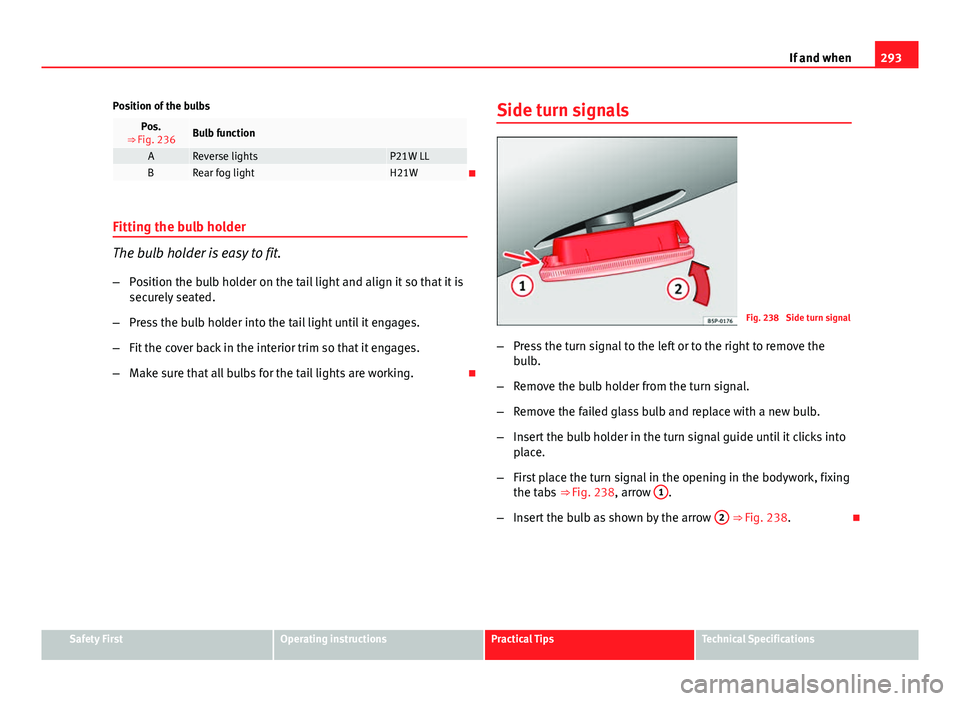
293
If and when
Position of the bulbs
Pos.
⇒ Fig. 236Bulb function
AReverse lightsP21W LLBRear fog lightH21W
Fitting the bulb holder
The bulb holder is easy to fit. – Position the bulb holder on the tail light and align it so that it is
securely seated.
– Press the bulb holder into the tail light until it engages.
– Fit the cover back in the interior trim so that it engages.
– Make sure that all bulbs for the tail lights are working. Side turn signals
Fig. 238 Side turn signal
– Press the turn signal to the left or to the right to remove the
bulb.
– Remove the bulb holder from the turn signal.
– Remove the failed glass bulb and replace with a new bulb.
– Insert the bulb holder in the turn signal guide until it clicks into
place.
– First place the turn signal in the opening in the bodywork, fixing
the tabs ⇒ Fig. 238, arrow 1
.
– Insert the bulb as shown by the arrow 2
⇒ Fig. 238.
Safety FirstOperating instructionsPractical TipsTechnical Specifications
Page 296 of 327
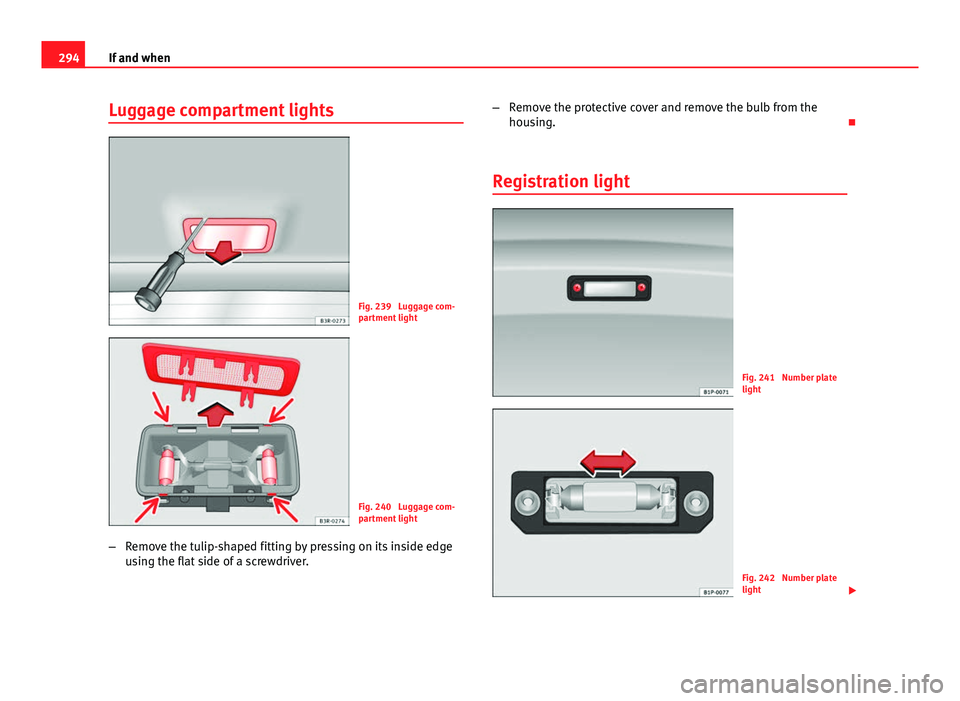
294If and when
Luggage compartment lights
Fig. 239 Luggage com-
partment light
Fig. 240 Luggage com-
partment light
– Remove the tulip-shaped fitting by pressing on its inside edge
using the flat side of a screwdriver. –
Remove the protective cover and remove the bulb from the
housing.
Registration light
Fig. 241 Number plate
light
Fig. 242 Number plate
light
Page 297 of 327
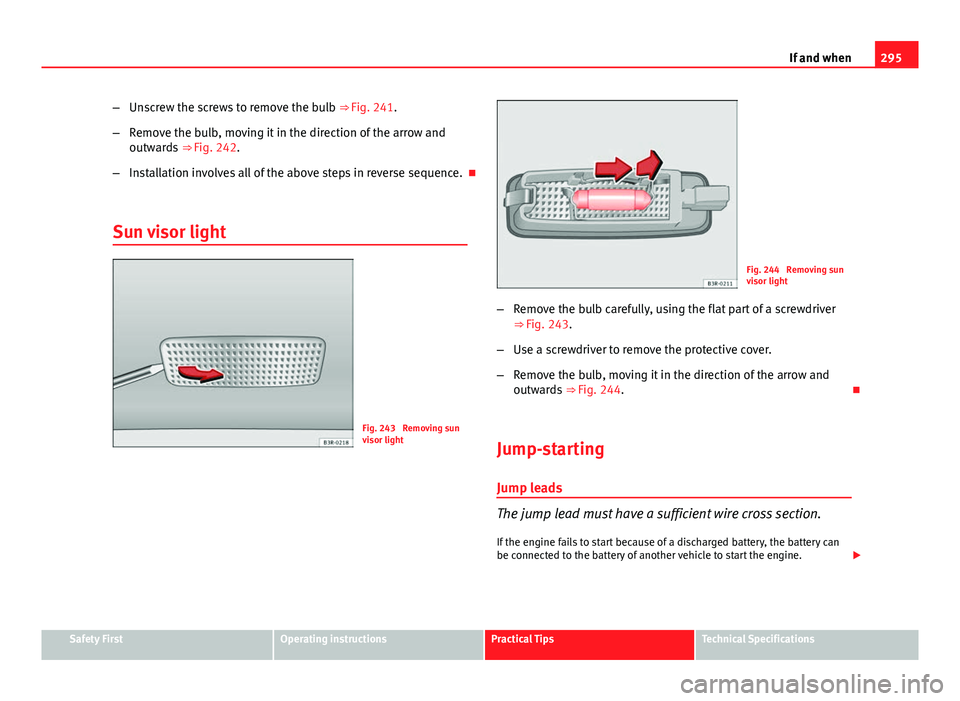
295
If and when
– Unscrew the screws to remove the bulb ⇒ Fig. 241.
– Remove the bulb, moving it in the direction of the arrow and
outwards ⇒ Fig. 242.
– Installation involves all of the above steps in reverse sequence.
Sun visor light
Fig. 243 Removing sun
visor light
Fig. 244 Removing sun
visor light
– Remove the bulb carefully, using the flat part of a screwdriver
⇒ Fig. 243.
– Use a screwdriver to remove the protective cover.
– Remove the bulb, moving it in the direction of the arrow and
outwards ⇒ Fig. 244.
Jump-starting
Jump leads
The jump lead must have a sufficient wire cross section. If the engine fails to start because of a discharged battery, the battery can
be connected to the battery of another vehicle to start the engine.
Safety FirstOperating instructionsPractical TipsTechnical Specifications
Page 298 of 327
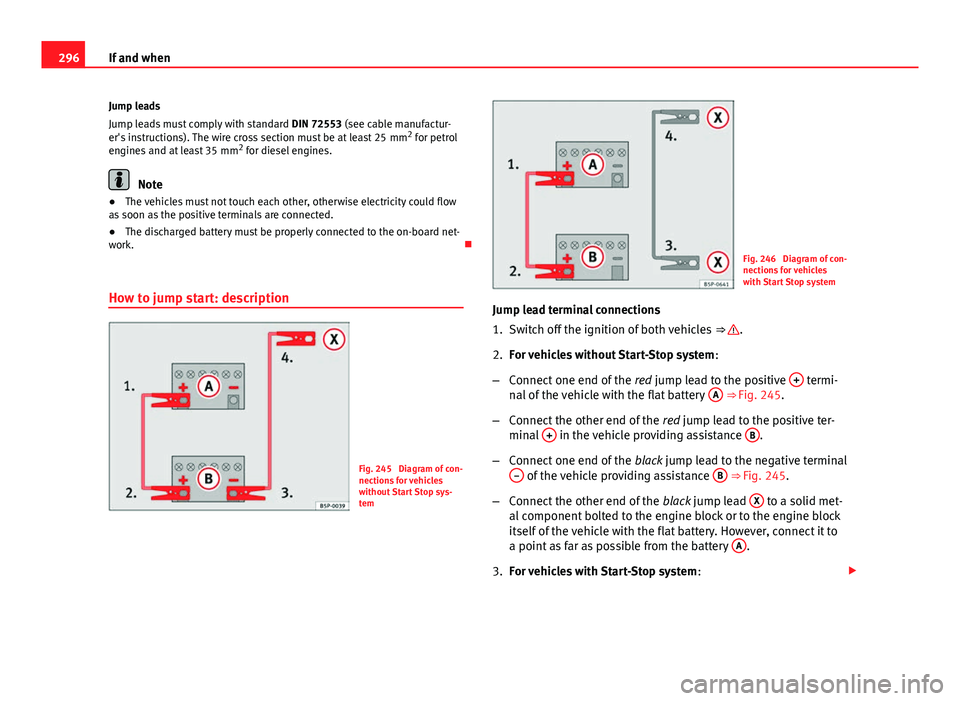
296If and when
Jump leads
Jump leads must comply with standard DIN 72553 (see cable manufactur-
er's instructions). The wire cross section must be at least 25 mm 2
for petrol
engines and at least 35 mm 2
for diesel engines.
Note
● The vehicles must not touch each other, otherwise electricity could flow
as soon as the positive terminals are connected.
● The discharged battery must be properly connected to the on-board net-
work.
How to jump start: description
Fig. 245 Diagram of con-
nections for vehicles
without Start Stop sys-
tem
Fig. 246 Diagram of con-
nections for vehicles
with Start Stop system
Jump lead terminal connections
1. Switch off the ignition of both vehicles ⇒
.
2. For vehicles without Start-Stop system :
– Connect one end of the red jump lead to the positive +
termi-
nal of the vehicle with the flat battery A ⇒ Fig. 245.
– Connect the other end of the red jump lead to the positive ter-
minal +
in the vehicle providing assistance B.
– Connect one end of the black jump lead to the negative terminal
–
of the vehicle providing assistance B ⇒ Fig. 245.
– Connect the other end of the black jump lead X
to a solid met-
al component bolted to the engine block or to the engine block
itself of the vehicle with the flat battery. However, connect it to
a point as far as possible from the battery A
.
3. For vehicles with Start-Stop system :
Page 299 of 327
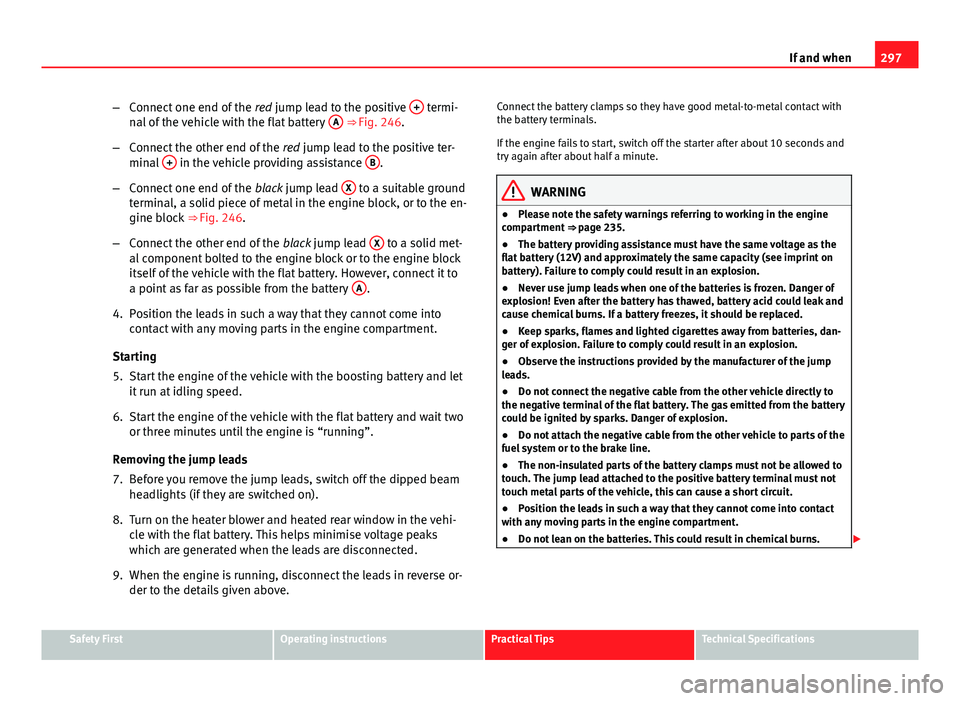
297
If and when
– Connect one end of the red jump lead to the positive +
termi-
nal of the vehicle with the flat battery A ⇒ Fig. 246.
– Connect the other end of the red jump lead to the positive ter-
minal +
in the vehicle providing assistance B.
– Connect one end of the black jump lead X
to a suitable ground
terminal, a solid piece of metal in the engine block, or to the en-
gine block ⇒ Fig. 246.
– Connect the other end of the black jump lead X
to a solid met-
al component bolted to the engine block or to the engine block
itself of the vehicle with the flat battery. However, connect it to
a point as far as possible from the battery A
.
4. Position the leads in such a way that they cannot come into contact with any moving parts in the engine compartment.
Starting
5. Start the engine of the vehicle with the boosting battery and let it run at idling speed.
6. Start the engine of the vehicle with the flat battery and wait two or three minutes until the engine is “running”.
Removing the jump leads
7. Before you remove the jump leads, switch off the dipped beam headlights (if they are switched on).
8. Turn on the heater blower and heated rear window in the vehi- cle with the flat battery. This helps minimise voltage peaks
which are generated when the leads are disconnected.
9. When the engine is running, disconnect the leads in reverse or- der to the details given above. Connect the battery clamps so they have good metal-to-metal contact with
the battery terminals.
If the engine fails to start, switch off the starter after about 10 seconds and
try again after about half a minute.
WARNING
● Please note the safety warnings referring to working in the engine
compartment ⇒ page 235.
● The battery providing assistance must have the same voltage as the
flat battery (12V) and approximately the same capacity (see imprint on
battery). Failure to comply could result in an explosion.
● Never use jump leads when one of the batteries is frozen. Danger of
explosion! Even after the battery has thawed, battery acid could leak and
cause chemical burns. If a battery freezes, it should be replaced.
● Keep sparks, flames and lighted cigarettes away from batteries, dan-
ger of explosion. Failure to comply could result in an explosion.
● Observe the instructions provided by the manufacturer of the jump
leads.
● Do not connect the negative cable from the other vehicle directly to
the negative terminal of the flat battery. The gas emitted from the battery
could be ignited by sparks. Danger of explosion.
● Do not attach the negative cable from the other vehicle to parts of the
fuel system or to the brake line.
● The non-insulated parts of the battery clamps must not be allowed to
touch. The jump lead attached to the positive battery terminal must not
touch metal parts of the vehicle, this can cause a short circuit.
● Position the leads in such a way that they cannot come into contact
with any moving parts in the engine compartment.
● Do not lean on the batteries. This could result in chemical burns.
Safety FirstOperating instructionsPractical TipsTechnical Specifications
Page 300 of 327
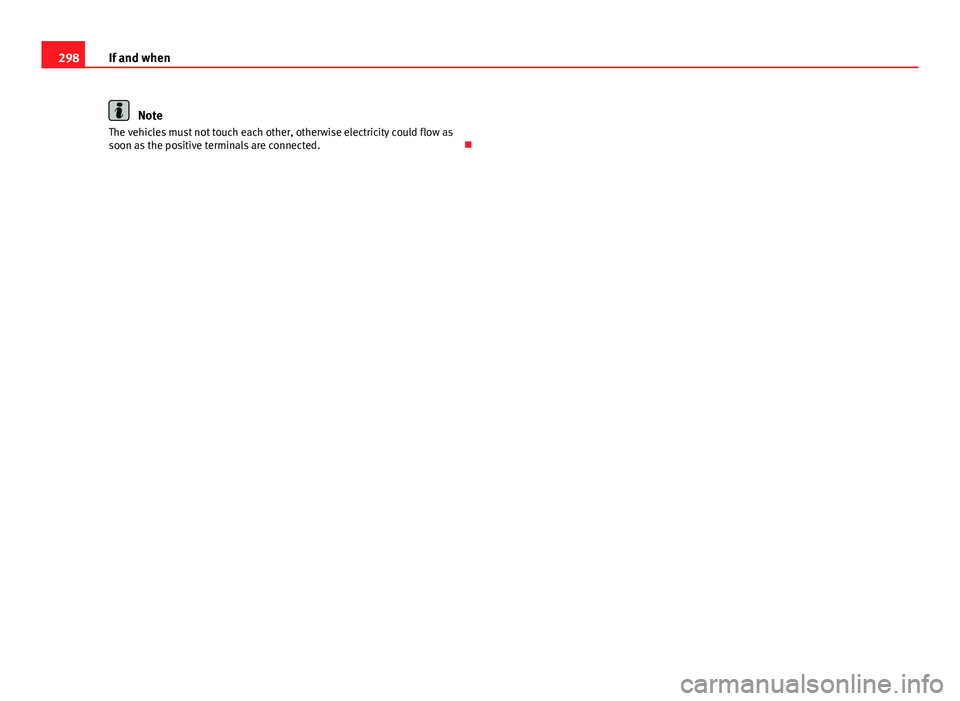
298If and when
Note
The vehicles must not touch each other, otherwise electricity could flow as
soon as the positive terminals are connected.